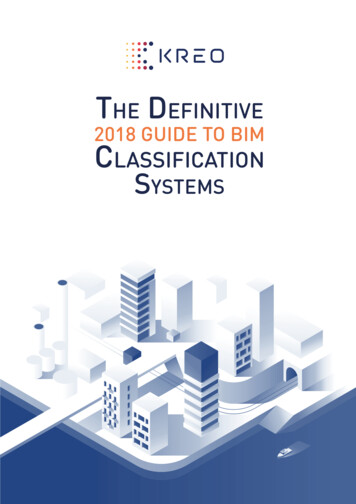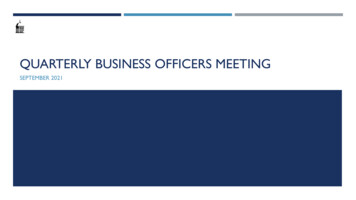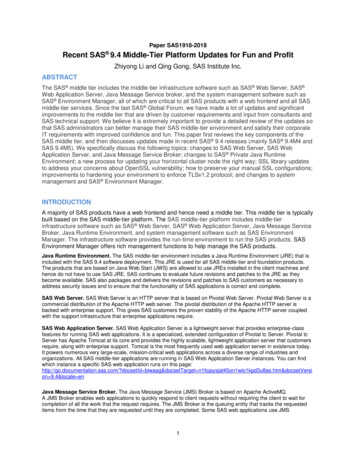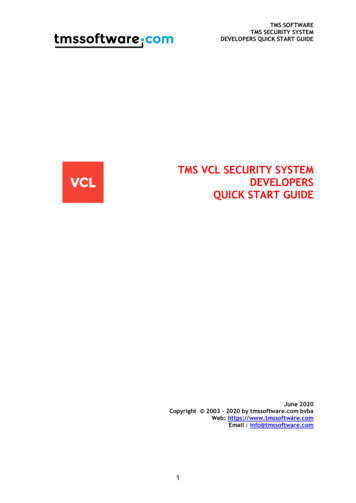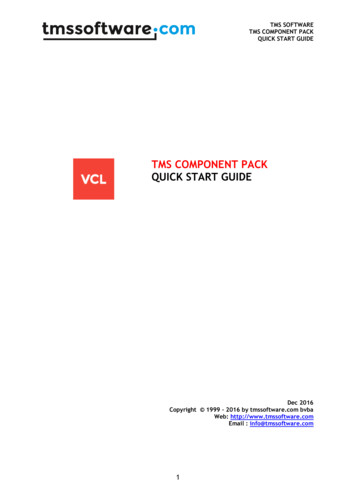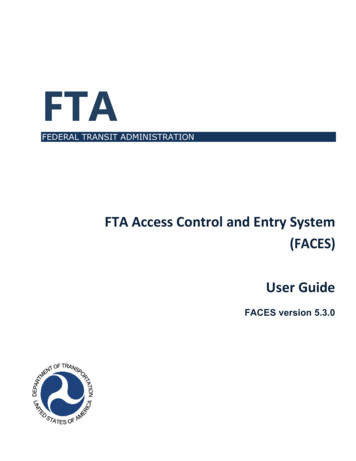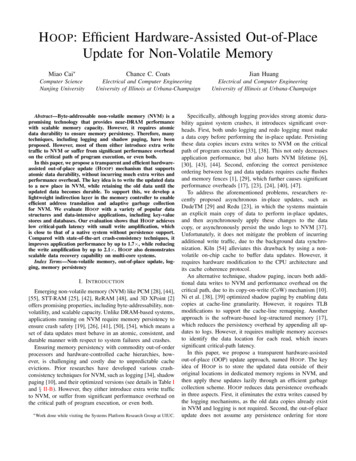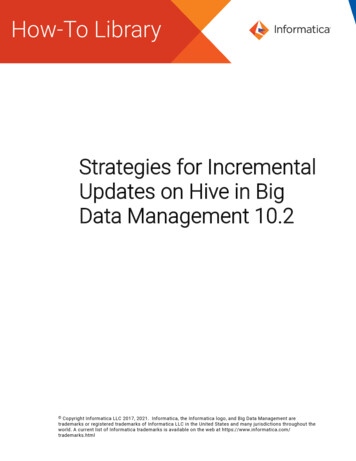
Transcription
Strategies for IncrementalUpdates on Hive in BigData Management 10.2 Copyright Informatica LLC 2017, 2021. Informatica, the Informatica logo, and Big Data Management aretrademarks or registered trademarks of Informatica LLC in the United States and many jurisdictions throughout theworld. A current list of Informatica trademarks is available on the web at https://www.informatica.com/trademarks.html
AbstractThis article describes alternative solutions to the Update Strategy transformation for updating Hive tables to supportincremental loads. These solutions include updating Hive tables using the Update Strategy transformation, UpdateStrategy transformation with the MERGE statement, partition merge solution, and key-value stores.Supported Versions Informatica Big Data Management 10.2Table of ContentsOverview. . . . . . . . . . . . . . . . . . . . . . . . . . . . . . . . . . . . . . . . . . . . . . . . . . . . . . . . . . . . . . . . . . 2Approach 1. Update Strategy Transformation. . . . . . . . . . . . . . . . . . . . . . . . . . . . . . . . . . . . . . . . . . 2Approach 3. Partition Merge. . . . . . . . . . . . . . . . . . . . . . . . . . . . . . . . . . . . . . . . . . . . . . . . . . . . . 3Create a Partition Merge. . . . . . . . . . . . . . . . . . . . . . . . . . . . . . . . . . . . . . . . . . . . . . . . . . . . . . 4Tune the Partition Merge Solution for Optimal Performance. . . . . . . . . . . . . . . . . . . . . . . . . . . . . . . 5Case Study: Partition Merge (On-Premise Test Setup). . . . . . . . . . . . . . . . . . . . . . . . . . . . . . . . . . . 5Approach 4. Key-Value Stores. . . . . . . . . . . . . . . . . . . . . . . . . . . . . . . . . . . . . . . . . . . . . . . . . . . . 5Tune HBase Tables for Optimal Performance . . . . . . . . . . . . . . . . . . . . . . . . . . . . . . . . . . . . . . . . 7Strategy Comparison. . . . . . . . . . . . . . . . . . . . . . . . . . . . . . . . . . . . . . . . . . . . . . . . . . . . . . . . . . 7Case Study: Partition Merge vs. Key-Value Stores (EMR Test Setup). . . . . . . . . . . . . . . . . . . . . . . . . . 8Solution Recommendations. . . . . . . . . . . . . . . . . . . . . . . . . . . . . . . . . . . . . . . . . . . . . . . . . . . . . . 9OverviewMany organizations want to create data lakes and enterprise data warehouses on Hadoop clusters to perform nearreal-time analytics based on business requirements. Building data lakes on a Hadoop cluster requires a one-time initialload from legacy warehouse systems and frequent incremental loads. In most cases, Hive is the preferred analyticstore.Although Hive versions 0.13 and later support transactions, they pose challenges with incremental loads, such aslimited ACID compliance and requirements for ORC file formats and bucketed tables.This article describes various strategies for updating Hive tables to support incremental loads and ensuring thattargets are in sync with source systems.Informatica Big Data Management supports the following methods to perform incremental updates: Update Strategy transformation Update Strategy transformation using MERGE statement Updates using the partition merge solution Updates using key-value storesApproach 1. Update Strategy TransformationYou can use an Update Strategy transformation to update Hive ACID tables. You can define expressions in an UpdateStrategy transformation with IIF or DECODE functions to set rules for updating rows. For example, the following IIF2
function detects and marks a row for reject if the entry date is after the apply date. Otherwise, the function marks therow for update:IIF ((ENTRY DATE APPLY DATE), DD REJECT, DD UPDATE)The following image shows the Update Strategy transformation with an IIF function:When using the Update Strategy transformation, the following restrictions apply to Cloudera and Amazon EMRdistributions: Cloudera CDH. Discourages using ORC file format, which is a prerequisite for Hive transactions. Amazon EMR. Due to the limitation in HIVE-17221, the Update Strategy transformation on transaction enabledpartitioned Hive tables fails.Therefore, you must use an alternative strategy to update Hive tables without enabling Hive transactions.For more information about the Update Strategy transformation, see the Informatica 10.2.1 Big Data Management UserGuide.Approach 3. Partition MergeThe partition merge solution detects, stages, and updates only the impacted partitions based on the incrementalrecords from upstream systems.To develop a mapping using the partition merge solution, you use the following types of input sources:Incremental tableHolds the incremental change records from any upstream system that indicate whether a row is marked forinsert, update, or delete. Incremental tables must have an identifier in the form of an expression or a columnthat indicates whether the incoming row is marked for insert, update, or delete.Historic base tableA target table that initially holds all records from the source system. After the initial processing cycle, itmaintains a copy of the most up-to-date synchronized record set from the source.Temporary insert base tableA temporary target table that holds all insert records. The insert records are eventually loaded into thehistoric base table.3
Temporary update base tableA temporary target table that holds all update records after the rows marked for delete have been removed.The update records are eventually loaded into the historic base table.Create a Partition MergeTo implement the partition merge solution, you create three mappings. The first mapping has two branches. Onebranch writes inserts to the temporary base insert table. The other branch processes the update and delete operationsseparately, and merges with a Union transformation before writing to the temporary base update table. The second twomappings are pass-through mappings that insert the temporary tables into the historic base table.The following image is a graphical representation of the partition merge solution:Perform the following steps to implement the partition merge solution:1.Define a Router transformation to separate insert operations from update and delete operations. Create onepipeline to process the inserts, and one pipeline to process the updates and deletes.2.Define an Aggregator transformation to group the rows marked for update and delete based on thepartitioned column and detect the impacted partitions.3.Define a Joiner transformation to join the Aggregator output with the historic base table on the partitionedcolumn and fetch rows only for those impacted partitions.4.Define a Filter transformation to filter out rows marked for update. Join them with the impacted partitions toget all updatable records.5.Use a detail outer join and filter NULL keys to perform a minus operation on the impacted partitions. Theminus operation eliminates rows marked for delete and rows from the historic base table that were updated.6.Define a Union transformation to merge the resulting rows from Step 4 and Step 5 and insert them into thetemporary base update table. Enable the Truncate Hive Target Partition option on the temporary update basetable.7.Add the insert rows into the temporary update base table.Note: Use a workflow to ensure that Step 6 runs before Step 7. Hadoop mappings do not support target loadorder constraints.4
8.Create a pass-through mapping to load the temporary insert base table into the historic base table.9.Create a pass-through mapping to load the temporary update base table into the historic base table.Tune the Partition Merge Solution for Optimal PerformanceUse the following optimization techniques to get the best performance results based on your requirements: Do not require Hive transactions to be enabled, and ensure that ACID transactions are disabled. Inserts intotransaction enabled Hive tables are approximately three to five times slower than inserts into transactiondisabled Hive tables. Configure partitions so that each partition has approximately 5-10 GB of data. The partition merge solutionperforms updates by identifying the impacted partitions. These updates are efficient when the data is welldistributed across many partitions.Case Study: Partition Merge (On-Premise Test Setup)It is important to distribute data across multiple partitions. Based on Informatica internal testing, updates to Hivetables with 50 partitions perform three to five times faster than updates to tables with five partitions.Approach 4. Key-Value StoresInserts into key-value stores are treated as upserts, so they are a convenient choice for handling updates.This article uses HBase as the primary key-value store and restricts the discussion around it. HBase is a non-relational(NoSQL) database that runs on top of HDFS and performs random reads and writes against large datasets.5
Unlike MapReduce which is mostly I/O bound, HBase is both CPU and memory intensive with sporadic, large, andsequential input and output operations. This advantage comes at a cost in the form of additional system resourcerequirements on the cluster nodes.HBase handles deletes by marking rows as "deleted" and removing the data during compaction.HBase tables are split into chunks of rows called "regions" which are distributed across the cluster and managed by theRegionServer process. By default, HBase allocates only one region per table. Thus, during initial load, all requests go toa single region server regardless of the number of available region servers on the cluster.Informatica Big Data Management provides native HBase connectors to write to HBase. Create a pass-throughmapping with incremental records as the source and an HBase table as the target.The following image shows an HBase source data object and data object operation:HBase is a key-value store. For relational (/SQL) database views, either use Apache Phoenix or use HBase storagehandlers to create a Hive table.The following example shows a Hive table created with HBase storage handlers:create table orders(rowkey STRING,orderKey STRING,custKey STRING,orderStatus STRING,totalPrice DOUBLE)stored by 6
with serdeproperties("hbase.columns.mapping" "cf: orderKey, cf:custKey,cf: orderStatus, cf: totalPrice)tblproperties ("hbase.table.name" "orders hbase");Tune HBase Tables for Optimal PerformanceYou can pre-split HBase tables to ensure even distribution throughout the cluster. With pre-splitting, you can create atable with many regions by supplying the split points at the table creation time. Because pre-splitting ensures that theinitial load is more evenly distributed throughout the cluster, you should always consider using it if you know your keydistribution.You can use predefined algorithms like HexStringSplit and UniformSplit, or implement a custom SplitAlgorithm.For example, the following command pre-splits HBase tables using HexStringSplit:hbase org.apache.hadoop.hbase.util.RegionSplitter orders hbase HexStringSplit -c 32 -f cfWhere: -c is number of splits. -f is the column family name.When you use HexStringSplit, define rowkey as Strings.Determining the number of splits depends on several factors, including the type of data mapped to the rowkey, the datavolume, and the amount of resources available for region servers across the cluster.Consider allocating approximately 20 splits for every gigabyte of data.Strategy ComparisonThe following table compares the different strategies:7StrategyAdvantagesDisadvantagesUpdate Strategy Transformation- It is simple and easy to- Cloudera discourages using ORC format andUpdate Strategy TransformationUsing MERGE Statement- The MERGE statement can- The Blaze and Hive engines do not supportimplement.generate efficient HiveQL andprovide overall improvedperformance.Hive ACID properties. Both are prerequisites forthe Update Strategy transformation.- On Amazon EMR 5.4, Update Strategy is notsupported for partitioned, transaction enabledHive tables due to a Hive bug.Update Strategy transformation using theMERGE statement.- With Cloudera CDH, it is not recommended touse ORC file format. ORC file format is aprerequisite for Hive transactions. You must usean alternative strategy to update Hive tableswithout enabling Hive transactions.- Due to the Amazon EMR limitation in HIVE-17221,the Update Strategy transformation ontransaction enabled partitioned Hive tables fails.
StrategyAdvantagesDisadvantagesPartition Merge Solution- Works on any Hadoop- Does not support updating the entire Hive-Key-Value Storesdistribution.No need for ACID transactionson Hive.Hive tables do not need to bebucketed.Hive tables can use any Hivesupported file format.With the correct partitioningstrategy, this approach scaleswell for extremely largedatasets.- No need for ACID transactionson Hive.- HBase implements inserts asupserts, which is convenientfor handling incrementalupdates.partition (i.e. updating all records from within apartition).- You must understand the underlying datadistribution to decide on the correct partitioningstrategy.- Informatica Big Data Management does nothandle delete operations.- Delete operations must be forked as a separatestandalone query.- HBase stores are not efficient for large scans.- HBase is CPU, memory, and I/O intensive andwill compete for additional system resources onthe cluster.- Key-value stores are not intended for large datavolumes greater than 500 GB.Case Study: Partition Merge vs. Key-Value Stores (EMR Test Setup)The following case study uses HBase as the key-value store.8
Solution RecommendationsTo optimize updating Hive tables to support incremental loads:Update Strategy transformationUse the Update Strategy transformation on all Hadoop distributions except Cloudera and Amazon EMR. OnCloudera and Amazon EMR distributions, when an Update Strategy transformation is not a practical option,you can use the partition merge solution or key-value stores to perform updates.Update Strategy transformation using MERGE statementUse the Update Strategy transformation with the MERGE statement on all Hadoop distributions exceptCloudera and Amazon EMR. On Cloudera and Amazon EMR distributions, you can use the partition mergesolution or key-value stores to perform updates. The Blaze and Hive engines do not support Update Strategytransformation using the MERGE statement.Key-value storesUse key-value stores only if the cluster is already configured to use the database services and the datavolume is less than 200 GB. Key-value stores such as HBase are NoSQL databases. These databases requireApache Phoenix or Hive tables with HBase storage handlers to provide relational (/SQL) database views.HBase is also CPU, memory, and I/O intensive.Partition mergeUse the partition merge solution if you understand the underlying data distribution. You must choose thecorrect partitioning strategy so that the data is uniformly distributed across partitions with approximately5-10 GB of data per partition. The partition merge solution scales well for large datasets.AuthorsShruti BuchNeha VelhankarElizabeth Snyder9
Informatica Big Data Management suppor ts the following methods to per form incremental updates: . Strategy transformation with IIF or DECODE functions to set rules for updating rows. For example, the following IIF 2. function detects and marks a row for reject if the entr y date is after the apply date. Other wise, the function marks the



